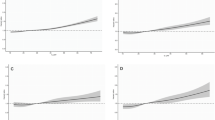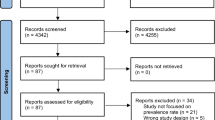Abstract
Introduction
Chronic inflammation is associated with increased risk of cancer, cardiovascular disease (CVD), and diabetes. The role of pro-inflammatory diet in the risk of cancer mortality and CVD mortality in prediabetics is unclear. We examined the relationship between diet-associated inflammation, as measured by dietary inflammatory index (DII) score, and mortality, with special focus on prediabetics.
Methods
This prospective cohort study used data from the Third National Health and Nutrition Examination Survey (NHANES III). We categorized 13,280 eligible participants, ages 20–90 years, according to glycosylated hemoglobin (HgbA1c) level and identified 2681 with prediabetes, defined as a glycosylated hemoglobin percentage of 5.7–6.4. Computation of DII scores and all statistical analyses were conducted in 2015. The DII was computed based on baseline dietary intake assessed using 24-h dietary recalls (1988–1994). Mortality was determined from the National Death Index records through 2006. Over follow-up ranging between 135 and 168 person-months, a total of 3016 deaths were identified, including 676 cancer, 192 lung cancer, 176 digestive-tract cancer, and 1328 CVD deaths. Cox proportional hazard regression was used to estimate hazard ratios.
Results
The prevalence of prediabetes was 20.19 %. After controlling for age, sex, race, HgbA1c, current smoking, physical activity, BMI, and systolic blood pressure, DII scores in tertile III (vs tertile I) was significantly associated with mortality from all causes (HR 1.39, 95 % CI 1.13, 1.72), CVD (HR 1.44, 95 % CI 1.02, 2.04), all cancers (HR 2.02, 95 % CI 1.27, 3.21), and digestive-tract cancer (HR 2.89, 95 % CI 1.08, 7.71). Findings for lung cancer (HR 2.01, 95 % CI 0.93, 4.34) suggested a likely effect. These results were moderately enhanced after additional adjustment for serum low-density lipoprotein and triglyceride and following eliminating deaths during the first year.
Conclusions
A pro-inflammatory diet, as indicated by higher DII scores, is associated with an increased risk of all-cause, CVD, all-cancer, and digestive-tract cancer mortality among prediabetic subjects.
Similar content being viewed by others
References
Mellitus D (2005) Diagnosis and classification of diabetes mellitus. Diabetes Care 28:S37
Olson DE, Rhee MK, Herrick K, Ziemer DC, Twombly JG, Phillips LS (2010) Screening for diabetes and pre-diabetes with proposed A1C-based diagnostic criteria. Diabetes Care 33(10):2184–2189
Rydén L, Standl E, Bartnik M et al (2007) Guidelines on diabetes, pre-diabetes, and cardiovascular diseases: executive summary. The task force on diabetes and cardiovascular diseases of the European Society of Cardiology (ESC) and of the European Association for the Study of Diabetes (EASD). Eur Heart J 28(1):88–136
Cowie CC, Rust KF, Ford ES et al (2009) Full accounting of diabetes and pre-diabetes in the US population in 1988–1994 and 2005–2006. Diabetes Care 32(2):287–294
Control CfD Prevention, Control CfD Prevention (2011) National diabetes fact sheet: national estimates and general information on diabetes and prediabetes in the United States, 2011. Atlanta, GA: US Department of Health and Human Services, Centers for Disease Control and Prevention, 201
Nelson KM, Reiber G, Boyko EJ (2002) Diet and exercise among adults with type 2 diabetes findings from the third national health and nutrition examination survey (NHANES III). Diabetes Care 25(10):1722–1728
Orozco LJ, Buchleitner AM, Gimenez-Perez G, Roqué i Figuls M, Richter B, Mauricio D (2008) Exercise or exercise and diet for preventing type 2 diabetes mellitus. The Cochrane Library, Chichester
Shikata K, Ninomiya T, Kiyohara Y (2013) Diabetes mellitus and cancer risk: review of the epidemiological evidence. Cancer Sci 104(1):9–14
Zhou X, Qiao Q, Zethelius B et al (2010) Diabetes, prediabetes and cancer mortality. Diabetologia 53(9):1867–1876
Colberg SR, Sigal RJ, Fernhall B et al (2010) Exercise and type 2 diabetes the American College of Sports Medicine and the American Diabetes Association: joint position statement. Diabetes Care 33(12):e147–e167
Hu FB, Manson JE, Stampfer MJ et al (2001) Diet, lifestyle, and the risk of type 2 diabetes mellitus in women. N Engl J Med 345(11):790–797
Coussens LM, Werb Z (2002) Inflammation and cancer. Nature 420(6917):860–867
Festa A, D’Agostino R, Howard G, Mykkänen L, Tracy RP, Haffner SM (2000) Chronic subclinical inflammation as part of the insulin resistance syndrome the Insulin Resistance Atherosclerosis Study (IRAS). Circulation 102(1):42–47
Ridker PM, Cushman M, Stampfer MJ, Tracy RP, Hennekens CH (1997) Inflammation, aspirin, and the risk of cardiovascular disease in apparently healthy men. N Engl J Med 336(14):973–979
Shacter E, Weitzman SA (2002) Chronic inflammation and cancer. Oncology 16(2):217–232
Wang X, Bao W, Liu J et al (2013) Inflammatory markers and risk of type 2 diabetes a systematic review and meta-analysis. Diabetes Care 36(1):166–175
Galland L (2010) Diet and inflammation. Nutr Clin Pract 25(6):634–640. doi:10.1177/0884533610385703
Geraldo JM, Alfenas RC (2008) Role of diet on chronic inflammation prevention and control: current evidences. Arq Bras Endocrinol Metabol 52(6):951–967
Hardman WE (2014) Diet components can suppress inflammation and reduce cancer risk. Nutr Res Pract 8(3):233–240. doi:10.4162/nrp.2014.8.3.233
Lee H, Lee IS, Choue R (2013) Obesity, inflammation and diet. Pediatr Gastroenterol Hepatol Nutr 16(3):143–152. doi:10.5223/pghn.2013.16.3.143
Uusitupa M, Schwab U (2013) Diet, inflammation and prediabetes-impact of quality of diet. Can J Diabetes 37(5):327–331. doi:10.1016/j.jcjd.2013.07.029
Esmaillzadeh A, Kimiagar M, Mehrabi Y, Azadbakht L, Hu FB, Willett WC (2007) Dietary patterns and markers of systemic inflammation among Iranian women. J Nutr 137(4):992–998
Lopez-Garcia E, Schulze MB, Fung TT et al (2004) Major dietary patterns are related to plasma concentrations of markers of inflammation and endothelial dysfunction. Am J Clin Nutr 80(4):1029–1035
Mozaffarian D, Pischon T, Hankinson SE et al (2004) Dietary intake of trans fatty acids and systemic inflammation in women. Am J Clin Nutr 79(4):606–612
Lichtenstein AH, Erkkilä AT, Schwab US, Jalbert SM, Ausman LM (2003) Influence of hydrogenated fat and butter on CVD risk factors: remnant-like particles, glucose and insulin, blood pressure and C-reactive protein. Atherosclerosis 171(1):97–107
Cavicchia PP, Steck SE, Hurley TG et al (2009) A new dietary inflammatory index predicts interval changes in serum high-sensitivity C-reactive protein. J Nutr 139(12):2365–2372
Shivappa N, Steck SE, Hurley TG, Hussey JR, Hébert JR (2014) Designing and developing a literature-derived, population-based dietary inflammatory index. Public Health Nutr 17(08):1689–1696
Shivappa N, Hébert JR, Rietzschel ER et al (2015) Associations between dietary inflammatory index and inflammatory markers in the Asklepios Study. Br J Nutr 113(04):665–671
Wood LG, Shivappa N, Berthon BS, Gibson PG, Hebert JR (2015) Dietary inflammatory index is related to asthma risk, lung function and systemic inflammation in asthma. Clin Exp Allergy 45(1):177–183
Tabung FK, Steck SE, Zhang J et al (2015) Construct validation of the dietary inflammatory index among postmenopausal women. Ann Epidemiol 25(6):398–405
Shivappa N, Prizment AE, Blair CK, Jacobs DR, Steck SE, Hébert JR (2014) Dietary inflammatory index and risk of colorectal cancer in the Iowa Women’s Health Study. Cancer Epidemiol Biomark Prev 23(11):2383–2392
Tabung FK, Steck SE, Ma Y et al (2014) The association between dietary inflammatory index and risk of colorectal cancer among postmenopausal women: results from the Women’s Health Initiative. Cancer Causes Control 26(3):399–408
Neufcourt L, Assmann K, Fezeu L et al (2015) Prospective association between the dietary inflammatory index and metabolic syndrome: findings from the SU. VI. MAX study. Nutr Metab Cardiovasc Dis 25(11):988–996
Garcia-Arellano A, Ramallal R, Ruiz-Canela M et al (2015) Dietary inflammatory index and incidence of cardiovascular disease in the PREDIMED Study. Nutrients 7(6):4124–4138
Control CfD Prevention (1996) The Third National Health and Nutrition Examination Survey (NHANES III, 1988–1994): reference manuals and reports. Maryland
Shivappa N, Steck SE, Hurley TG et al (2014) A population-based dietary inflammatory index predicts levels of C-reactive protein in the Seasonal Variation of Blood Cholesterol Study (SEASONS). Public Health Nutr 17(08):1825–1833
Stevens JW, Khunti K, Harvey R et al (2015) Preventing the progression to type 2 diabetes mellitus in adults at high risk: a systematic review and network meta-analysis of lifestyle, pharmacological and surgical interventions. Diabetes Res Clin Pract 107(3):320–331. doi:10.1016/j.diabres.2015.01.027
Nettleton JA, Steffen LM, Mayer-Davis EJ et al (2006) Dietary patterns are associated with biochemical markers of inflammation and endothelial activation in the Multi-Ethnic Study of Atherosclerosis (MESA). Am J Clin Nutr 83(6):1369–1379
Jacobs DR, Steffen LM (2003) Nutrients, foods, and dietary patterns as exposures in research: a framework for food synergy. Am J Clin Nutr 78(3):508S–513S
Drake I, Wallström P, Wirfält E (2013) What do review papers conclude about food and dietary patterns? Food Nutr Res 57:1–14
Howard BV, Robbins DC, Sievers ML et al (2000) LDL cholesterol as a strong predictor of coronary heart disease in diabetic individuals with insulin resistance and low LDL the Strong Heart Study. Arterioscler Thromb Vasc Biol 20(3):830–835
Isomaa B, Almgren P, Tuomi T et al (2001) Cardiovascular morbidity and mortality associated with the metabolic syndrome. Diabetes Care 24(4):683–689
Lu W, Resnick HE, Jablonski KA et al (2003) Non-HDL cholesterol as a predictor of cardiovascular disease in type 2 diabetes the strong heart study. Diabetes Care 26(1):16–23
Heidemann C, Schulze MB, Franco OH, van Dam RM, Mantzoros CS, Hu FB (2008) Dietary patterns and risk of mortality from cardiovascular disease, cancer, and all causes in a prospective cohort of women. Circulation 118(3):230–237
Mitrou PN, Kipnis V, Thiébaut AC et al (2007) Mediterranean dietary pattern and prediction of all-cause mortality in a US population: results from the NIH-AARP Diet and Health Study. Arch Intern Med 167(22):2461–2468
Osler M, Heitmann BL, Gerdes LU, Jørgensen LM, Schroll M (2001) Dietary patterns and mortality in Danish men and women: a prospective observational study. Br J Nutr 85(02):219–225
Shimazu T, Kuriyama S, Hozawa A et al (2007) Dietary patterns and cardiovascular disease mortality in Japan: a prospective cohort study. Int J Epidemiol 36(3):600–609
Jain M, Howe G, Harrison L, Miller A (1989) A study of repeatability of dietary data over a seven-year period. Am J Epidemiol 129(2):422–429
Jensen OM, Wahrendorf J, Rosenqvist A, Geser A (1984) The reliability of questionnaire-derived historical dietary information and temporal stability of food habits in individuals. Am J Epidemiol 120(2):281–290
Sijtsma FP, Meyer KA, Steffen LM et al (2012) Longitudinal trends in diet and effects of sex, race, and education on dietary quality score change: the coronary artery risk development in young adults study. Am J Clin Nutr 95(3):580–586
Thompson FE, Metzner HL, Lamphiear DE, Hawthorne VM (1990) Characteristics of individuals and long term reproducibility of dietary reports: the Tecumseh Diet Methodology Study. J Clin Epidemiol 43(11):1169–1178
Shivappa N, Steck SE, Hussey JR, Ma Y, Hebert JR (2015) Inflammatory potential of diet and all-cause, cardiovascular, and cancer mortality in National Health and Nutrition Examination Survey III Study. Eur J Nutr. doi:10.1007/s00394-015-1112-x
Acknowledgments
Drs. Shivappa and Hébert were supported by grant number R44DK103377 from the United States National Institute of Diabetes and Digestive and Kidney Diseases.
Author information
Authors and Affiliations
Corresponding author
Ethics declarations
Disclosure
Dr. James R. Hébert owns controlling interest in Connecting Health Innovations LLC (CHI), a company planning to license the right to his invention of the dietary inflammatory index (DII) from the University of South Carolina in order to develop computer and smart phone applications for patient counseling and dietary intervention in clinical settings. Dr. Nitin Shivappa is an employee of CHI. The authors have declared no conflict of interest.
Electronic supplementary material
Below is the link to the electronic supplementary material.
Rights and permissions
About this article
Cite this article
Deng, F.E., Shivappa, N., Tang, Y. et al. Association between diet-related inflammation, all-cause, all-cancer, and cardiovascular disease mortality, with special focus on prediabetics: findings from NHANES III. Eur J Nutr 56, 1085–1093 (2017). https://doi.org/10.1007/s00394-016-1158-4
Received:
Accepted:
Published:
Issue Date:
DOI: https://doi.org/10.1007/s00394-016-1158-4




